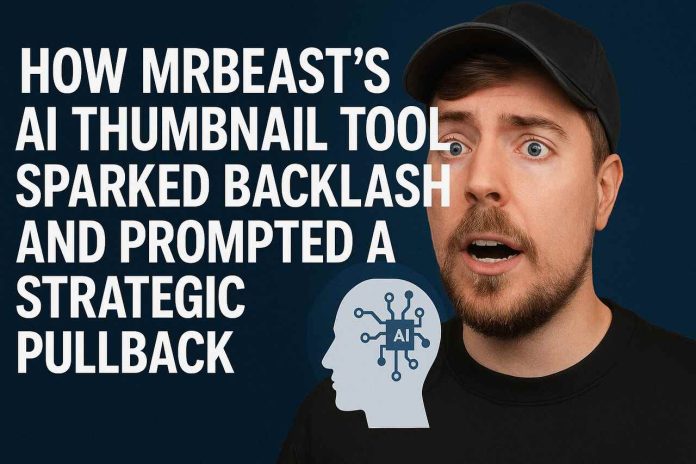What caused backlash against MrBeast’s AI thumbnail tool?
The release of an AI-driven thumbnail generator by MrBeast sparked significant resistance within the creator community. The automated tool imitated popular styles without proper attribution, causing creators to feel that their artistic identities were being exploited. Many users viewed the tool as a shortcut that ignored the individuality and labor invested in crafting distinctive visual content.
Key Factors Behind the Negative Reaction
-
Loss of Creative Ownership
Creators believed that the generator replicated signature visual elements used in their thumbnails. This replication diluted their brand uniqueness and made handcrafted content feel devalued. Many saw it as a threat to artistic control in a space defined by originality. -
Impersonal Mass Production
The tool enabled bulk creation of thumbnails, often producing designs that appeared generic and repetitive. This lack of personalization clashed with audience expectations of authenticity. Viewers expressed disappointment in seeing the same color gradients, face placements, and emotional cues recycled. -
Community Disconnection
Many fans felt that the introduction of such a tool signaled a shift away from community-based creativity toward mass automation. The perception grew that platforms favored scalability over user loyalty, igniting concerns about the commodification of creator work. -
Unethical Style Replication
Accusations surfaced that the generator had been trained using designs from established YouTubers without consent. The absence of credit or transparency around the training process raised ethical and legal questions regarding intellectual property and creative rights.
Why did MrBeast’s team decide to retract the tool?
Public criticism forced a rapid reconsideration of how the tool aligned with creator values. The decision to pause deployment reflected an intent to protect the creator economy and restore trust. Public sentiment held significant weight in the decision to pull the tool offline.
Main Drivers of the Decision
-
Reputation Management
The backlash threatened MrBeast’s image as a community-driven figure. Pulling the tool signaled humility and responsiveness. By prioritizing audience feedback, the brand positioned itself as sensitive to creator concerns. -
Reinforcing Fan Loyalty
Suspending the tool helped reaffirm the bond between creators and audiences. Acknowledging missteps served as an apology in action, which helped retain credibility and goodwill among both fans and fellow creators. -
Tool Re-Evaluation and Redesign
The team expressed intent to rework the tool with more input from the community. The focus moved toward creating something that enhances creator control rather than replacing it. The decision suggested future versions might offer customizable options or transparent sourcing methods. -
Shifting Priorities from Automation to Empathy
Feedback showed that automated growth at the cost of human connection was not acceptable. The incident highlighted the importance of empathy, creativity, and transparency when introducing tools into creative workflows.
What can content creators learn from the situation?
This event demonstrates the value of preserving authenticity and communication. While efficiency tools are tempting, creators must ensure these tools align with their brand identity and audience expectations. Adoption should focus on collaboration, not replacement.
Actionable Lessons for Creators
-
Preserve Your Creative Voice
While automation can help streamline production, retaining a unique voice is crucial. Custom thumbnails are often the first impression; they should reflect the creator’s narrative, not an algorithmic template. -
Maintain Transparency with Your Audience
Audiences respond to authenticity. Being open about the tools used and why they’re being used fosters trust. Creators who involve their communities in decision-making tend to build deeper loyalty. -
Understand the Tools Before Using Them
Not all AI or design tools are created with creators in mind. Evaluate the ethical implications and ensure tools do not infringe on others’ work or replicate styles without credit. -
Advocate for Ethical Development Standards
Creators should push for transparency from tool developers. Ensuring consent in training data, giving proper attribution, and allowing customization can prevent community fallout and reinforce mutual respect.
How should platforms balance innovation with creator integrity?
Technology must evolve in step with user values. Platforms need to prioritize community consultation and design tools that enhance, rather than replace, the human element. Creators want tools that empower—not erase—their identity.
Strategies for Responsible Innovation
-
Collaborative Product Testing
Engage with creators during development to gather insights and refine features. Community-based beta testing prevents misalignment and builds early trust. -
Creative Control and Customization Options
Allow creators to tweak, override, or fully customize AI outputs. A successful tool should complement a creator’s work, not override it. -
Clear Attribution and Data Ethics
Disclose how design patterns were sourced. Respecting intellectual property through attribution fosters a culture of trust and transparency. -
Ongoing Feedback Loops
Regular updates based on user input show commitment to improvement. Tools built through user feedback cycles are more likely to succeed long-term.
Conclusion
The rollout and pullback of MrBeast’s AI thumbnail tool highlight a pivotal moment in digital creativity. Automation must respect creator rights and audience values. By prioritizing transparency, feedback, and ethical practices, creators and platforms alike can thrive without compromising authenticity or trust.
